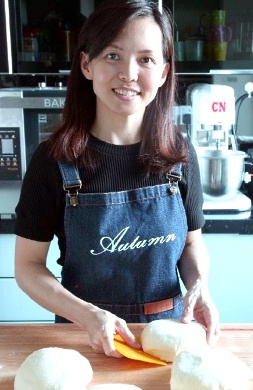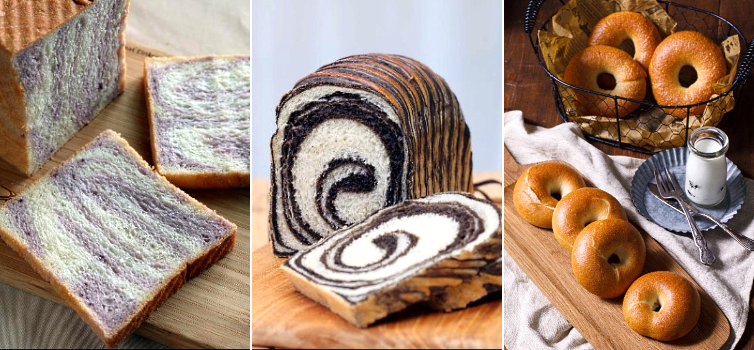
Sin Chew Daily
Sourdough is a kind of bread made of natural yeasts. The ingredients are very simple, just flour, water, salt and the most crucial "natural yeasts" fermented over a longer period of time for improved digestibility.
To urban folks so much accustomed to highly processed foods, sourdough offers a refreshing natural alternative.
Local baker Chiew See shares her tips of making irresistibly delicious and nutritious sourdough breads.
What is natural yeast"?

Natural yeast is nothing new.
"In the past when people were making bread, they would always leave a small piece of dough that would be left to ferment further for use next time.
"The concept of sourdough has been in existence for quite some time, but because of our highly commercialized world, we have come up with such commercialized 'new' products.
Natural yeasts began to gain traction over the past few years as people begin to embrace everything that is natural and traditional.
Some 12 years ago, Chiew See quit her engineering job in order to take care of her family and became a full-time housewife. That was when she started to learn baking.
In around 2013, when sourdough was still not very common in the local market, Chiew See came to know about it from a baking social media group, and spent the following two years studying it and understanding its principles and rhythm, in order to culture more and more active yeasts that could be made into more visually pleasant and tastier bread.
"As a matter of fact, yeasts are present in our everyday life although we can't see them with our naked eyes. You have yeasts everywhere, on tour skin, on the fruit peel, in the air and on the leaves."
Time-consuming process
There are many ways to culture the yeasts, and the most convenient and fundamental way is to ferment the mixture of flour with water.
The natural yeast is called sourdough because it will release lactic acid and acetobacter when feeding on food.
The stronger acidity will effectively inhibit the growth of bacteria, thus prolong the shelf life of bread.
As natural yeast is unprocessed, throughout the process of prolonged fermentation, it will disintegrate the carbohydrates in the dough to make the bread more easily digested, thus relieving the burden on human gastrointestinal tract and preventing bloating.
Other than the crusty soft European breads, natural yeasts can also be used to make soft toast breads, croissants, bagels, donuts, pizzas and even peanut pancakes and deep fried dough sticks.
Actually any pastry that requires yeasts can be made with natural yeasts instead of commercial yeasts.
Majority of bakeries in the market are using commercial yeasts which have very good leavening abilities, allowing the bakers to better control the process and improve production efficiency.
On the contrary, sourdough requires a lot of time to observe the fermenting process, and therefore involves much higher time and manpower costs. Due to the lower production volume, the selling price of sourdough bread is therefore costlier than usual breads.
Few bakers will invest the additional cost to make sourdough, and the products are not so common in ordinary bakery shops.

Practice makes perfect
Natural yeasts are microorganisms that act like a newborn baby that has very different moods each time we bake it.
The baker will only get to understand it much better through experience, close observation and own judgment in order to produce the best bread as if creating a soulful piece of artwork.
Like most other people, Chiew See was met with numerous setbacks with sourdough at the very beginning, and has only managed to gain an upper hand in baking after learning more about the nature of yeasts.
I'm sure many have the same experience: even if you follow very closely the steps in the recipe, you may not produce a perfect sourdough.
Chiew See explained, "First of all, the recipes might have been written overseas and the recipe has been designed based on the climate and environment there and may not necessarily be suited to our conditions here.
"Secondly, the flour we use may not be exactly the same, Moreover, different people may handle the ingredients differently and the slightest deviations could affect the fermentation process and the eventual taste of the bread."
As such, when we are following a recipe, we should not rely too much on the time specs in the recipe but must observe the changes taking place in the surrounding environment and temperature as well as the conditions of the fermentation process.
"Baking is not only a form of art, but is also a science. We can only master the skill if we understand the scientific principles behind the natural yeasts and sourdough."
Besides baking, Chiew See often takes the pictures of her baking and shares them on social media.
She wanted to publish her own cook book that would include her own recipes and pictures of her baking, and by chance she came to know a publisher who was willing to help publish her first book "Autumn Baking: Natural Yeasts".
She said laughingly, "Now that I have done well something which I once insisted to do, I hope the book will inspire my three children to appreciate the unyielding spirit of perseverance in their mother."

ADVERTISEMENT
ADVERTISEMENT


































